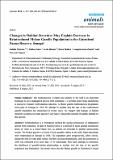Por favor, use este identificador para citar o enlazar a este item:
http://hdl.handle.net/10261/76922COMPARTIR / EXPORTAR:
 SHARE SHARE
 CORE
BASE CORE
BASE
|
|
| Visualizar otros formatos: MARC | Dublin Core | RDF | ORE | MODS | METS | DIDL | DATACITE | |

| Campo DC | Valor | Lengua/Idioma |
|---|---|---|
| dc.contributor.author | Moreno, Eulalia | - |
| dc.contributor.author | Sane, Abibou | - |
| dc.contributor.author | Benzal, Jesús | - |
| dc.contributor.author | Ibáñez, Belén | - |
| dc.contributor.author | Sanz-Zuasti, Joaquín | - |
| dc.contributor.author | Espeso, Gerardo | - |
| dc.date.accessioned | 2013-05-28T09:11:53Z | - |
| dc.date.available | 2013-05-28T09:11:53Z | - |
| dc.date.issued | 2012-08-08 | - |
| dc.identifier.citation | Animals 2:347-360 (2012) | es_ES |
| dc.identifier.issn | 2076-2615 | - |
| dc.identifier.uri | http://hdl.handle.net/10261/76922 | - |
| dc.description.abstract | The reintroduction of plants and animals to the wild is an important technique to save endangered species from extinction. To perform post release monitoring is crucial to evaluate reintroduction outcomes. A Mohor gazelle reintroduction programme took place in Senegal in 1984. We attempt to explain why the size of the reintroduced gazelle population has diminished in recent years. We suggest that changes in habitat structure occurred over time and have very likely reduced the amount of suitable habitat for this species. | es_ES |
| dc.description.sponsorship | This work has been funded by the Organismo Autónomo Parques Nacionales (belonging to the Spanish Ministry of Environment) under the UNESCO contract No. 4500124567. BI and JB have been supported by project CGL 2008-00562/BOS of the Spanish Ministry of Science and Innovation, and by the European Regional Development Fund. | es_ES |
| dc.language.iso | eng | es_ES |
| dc.publisher | Multidisciplinary Digital Publishing Institute | es_ES |
| dc.relation.isversionof | Publisher's version | - |
| dc.rights | openAccess | - |
| dc.subject | Evaluation of reintroduction | es_ES |
| dc.subject | Habitat structure | es_ES |
| dc.subject | Nanger dama mhorr | es_ES |
| dc.subject | Post release monitoring | es_ES |
| dc.subject | Senegal | es_ES |
| dc.title | Changes in Habitat Structure May Explain Decrease in Reintroduced Mohor Gazelle Population in the Guembeul Fauna Reserve, Senegal | es_ES |
| dc.type | artículo | - |
| dc.identifier.doi | 10.3390/ani2030347 | - |
| dc.description.peerreviewed | Peer reviewed | es_ES |
| dc.relation.publisherversion | http://dx.doi.org/10.3390/ani2030347 | es_ES |
| dc.rights.license | http://creativecommons.org/licenses/by/3.0/ | - |
| dc.contributor.funder | Ministerio de Ciencia e Innovación (España) | - |
| dc.contributor.funder | Organismo Autónomo Parques Nacionales (España) | - |
| dc.contributor.funder | European Commission | - |
| dc.contributor.funder | Consejo Superior de Investigaciones Científicas (España) | - |
| dc.relation.csic | Sí | - |
| dc.identifier.funder | http://dx.doi.org/10.13039/501100004837 | es_ES |
| dc.identifier.funder | http://dx.doi.org/10.13039/501100000780 | es_ES |
| dc.identifier.funder | http://dx.doi.org/10.13039/501100003339 | es_ES |
| dc.identifier.pmid | 26487026 | - |
| dc.type.coar | http://purl.org/coar/resource_type/c_6501 | es_ES |
| item.openairetype | artículo | - |
| item.fulltext | With Fulltext | - |
| item.openairecristype | http://purl.org/coar/resource_type/c_18cf | - |
| item.cerifentitytype | Publications | - |
| item.grantfulltext | open | - |
| item.languageiso639-1 | en | - |
| Aparece en las colecciones: | (EEZA) Artículos | |
Ficheros en este ítem:
| Fichero | Descripción | Tamaño | Formato | |
|---|---|---|---|---|
| Animals-Separata.pdf | 326,2 kB | Adobe PDF |  Visualizar/Abrir |
CORE Recommender
PubMed Central
Citations
2
checked on 30-abr-2024
SCOPUSTM
Citations
3
checked on 07-may-2024
Page view(s)
372
checked on 12-may-2024
Download(s)
213
checked on 12-may-2024

